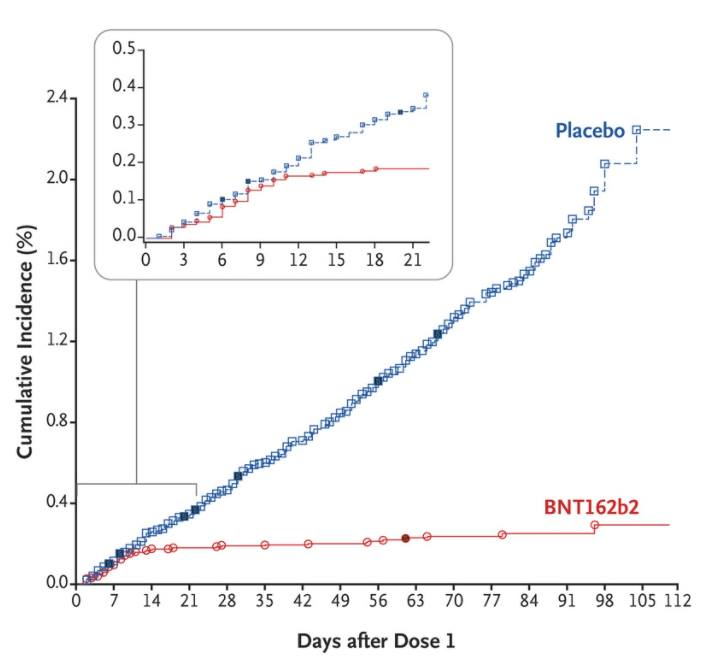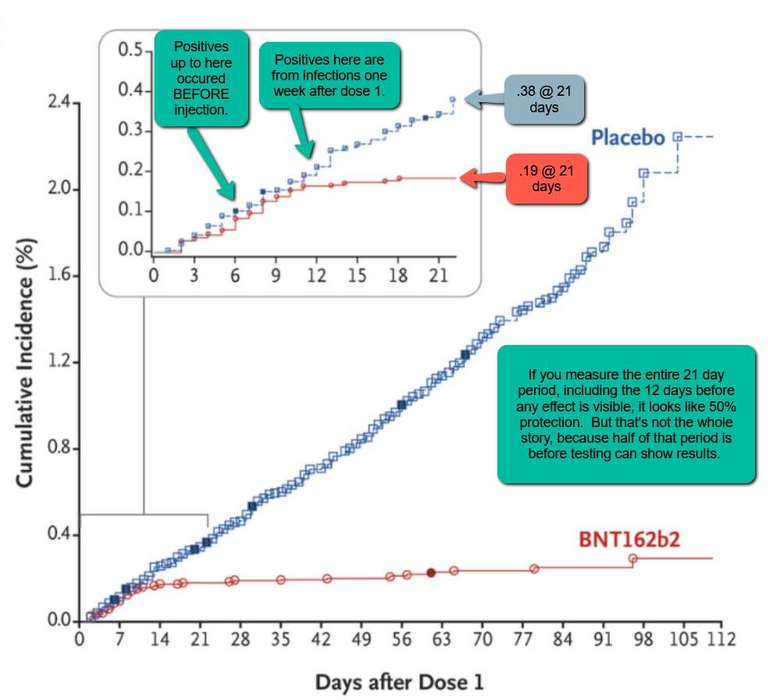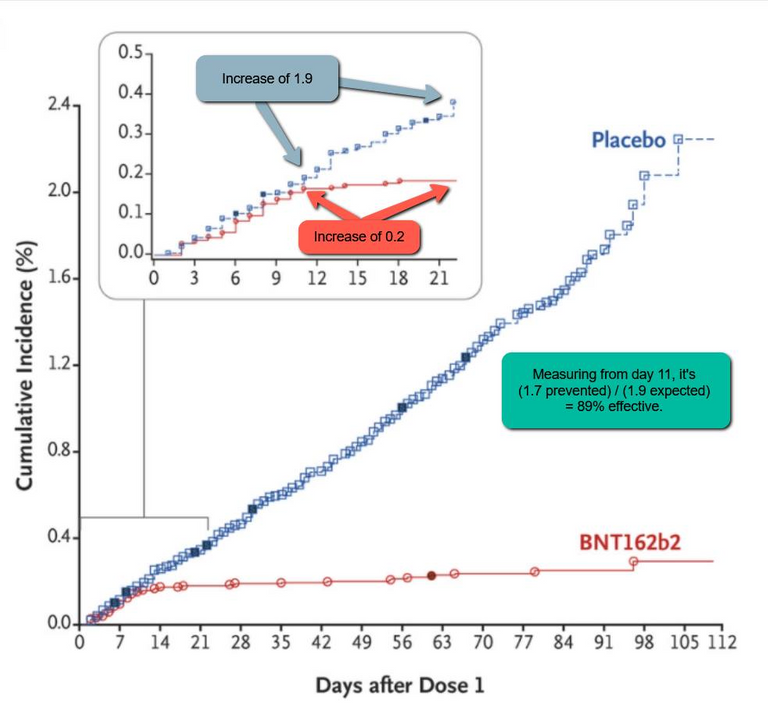
tl;dr - Despite news coverage stating otherwise, I think vaccines are very effective from 6 days after dose 1. Even vaccinated, though, you can still get less intense infections and spread the disease, so keep masking. It will probably make sense to lift restrictions sometime in the 2nd half of March, depending on how the vaccine vs. B.1.1.7 race unfolds.

Here are the key charts from phase 3 for Pfizer (left) and Moderna (right). It's important to understand these graphs if you want to understand how and when the vaccines take effect.
The red curves are the rate of infections detected in the placebo groups. The process was: patient gets symptoms, patient gets tested, result is logged by date...and then, at the end of the trial, they check to see who was in the placebo group and who was in the vaccine group.
As expected, the red charts show a rapidly rising cumulative rate of infection. The tests were run in different regions with different outbreak rates, so the minor differences in the shape of the placebo curve have NOTHING to do with how good the vaccines are, it just shows how prevalent the outbreak was in those regions. (Had the "third wave" not hit, it would have taken more months to get enough cases for solid statistics.)
The blue-green line is the cumulative rate of infections in the vaccine group. They start out in step with with placebo group for a couple of weeks, then diverge strongly. In both cases, the vaccine group almost flatlines - nearly no new infections.
To calculate efficacy, both companies had picked a point (in advance of the trial) to use for measurement. IIRC, both chose 14 days after dose 2, which would be day 35 for Pfizer and day 42 for Moderna. They then measured the number of cases in the placebo in vaccine groups from that day to the end of the trial, and found roughly 95% efficacy.
The sudden and extreme flattening of both of these vaccine group lines is a striking visual indication of how well they work.

Here's a zoom-in detail from the Pfizer graph; the Moderna one is almost identical. Look at the first two weeks. The red and blue lines are almost on top of each other through around day 11, then the vaccine line goes almost flat horizontal.
The colors are reversed in this one, red is the vaccine and blue is placebo.

When reviewing data, it's important to understand what it means and how it was collected. With one exception (later...), the subjects were not routinely given PCR tests for the virus. Instead, they waited for subjects to get symptoms, got them tested, and recorded the results. They simply logged the infection at this point, they wouldn't know who was control/placebo and who was treatment/vaccine until the unveiling at the end of the trial.
This means that there are delays due to the incubation period, and any delays in getting tested and seeing the results. COVID-19 has an average incubation of about 6 days, so the positives in the first six days were from people who had actually been infected before the first dose. New positives from days 7-14 were generally people infected in the first week after the first dose.

Many reports in the media indicate that the first dose is "about 50% effective". Depending on how you measure, this can be true...but it obscures the real picture.
If you include all the results from day 1 through 21 - including those who got infected before the injection, and those who got infected in the first few days after dose 1 - the math works out to 50% effective. But that's ignoring the fact that the vaccines can't protect against previous infection, and they do have some start-up delay before being effective.

If you allow five days for the vaccine to become effective, and six days for incubation and testing, you see a very different picture. This represents the segment of the graph after the point where the two lines diverge.
By measuring new cases after day 11, the Pfizer vaccine appears to be about 89% effective, suggesting very strong protection starting 5-6 days after dose 1.
Pfizer dose 2 was administered on day 21. If it also takes 5-6 days to have an impact, and another 6 for incubation and testing, it won't affect the charts until about day 32. (And close to day 40 for Moderna, with dose 2 at day 28.) You can see that the single-dose line through day 32 is showing no signs of weakening, which is one of the reasons the UK is going with deferred second doses to get more people covered.
From everything I can see, it looks like the two vaccines give you around 90% effectiveness at preventing disease starting about day 6 after the first dose. That's very different than the typical story in the news of "full protection starting two weeks after the second dose". While it's possible (even likely) that there's some improvement a week after dose 2, it's still very, very good with just dose 1.
So where does this "2 weeks after the 2nd dose" message come from? I think it's a misinterpretation of the results in the phase 3 reports.
Prior to starting the trials, both companies submitted plans for how the trials would be run. Part of the definition was picking the date that would be used to measure efficacy, necessary for FDA approval. IIRC, both companies understandably chose a very conservative date of 2nd dose plus 2 weeks, to get the highest possible efficacy rating in case the first dose wasn't full effective.
That led to quote about "95% effective 14 days after the 2nd dose", and I think that has been widely misinterpreted as implying that the protection is much lower before that point.
I do not have any knowledge about medicine, but I do understand and understand the time it can take to make these drugs and their effectiveness in active patients.
My sister-in-law is a doctor and she told me that to make a drug that she can attack this pandemic, it must take at least 2 to 3 years for tests. Without forgetting that COVID is mutating.
Who knows what is truly happening and what will become of humanity in the coming months, vaccines are reaching different parts of the world and we only have to wait and ask God that everything goes well.
The world is going around a thousand times and we don't know where we are going.
I like to focus on the tangible aspects of assessing where we are, and, where we're likely to be going.
I fully appreciate that for the vast majority of people (and for good reason), the responses and developments have left a lot to be desired as well as many more questions than there are answers. Unfortunately, such is the case for a once a generation crisis. Indeed, it remains to be seen how the world will come out of this in the months and years to come.. I'll leave that to the conspiracy theorists, however.
One thing I will add in response to your comment about the number of years required for "tests" -and by that I assume you mean the trials- it is true that these can and often do take even up to a decade. But we must remember that this not only a public health crisis, but a global pandemic. Enormous amounts of money have been funnelled towards accelerating the research and development of these vaccines, and very real tangible scientific breakthroughs have been made, in unprecedented time no less.
We remain a resilient species, and while I remain sceptical that we will survive in the longer run due to other more egregious self destructive behaviours, I do believe we will come out of this particular crisis relatively unscathed.
I hope with all my heart that we get through all of this and can continue.